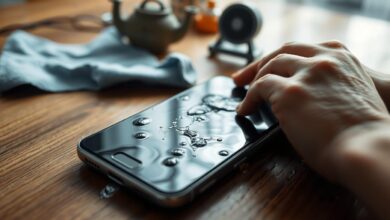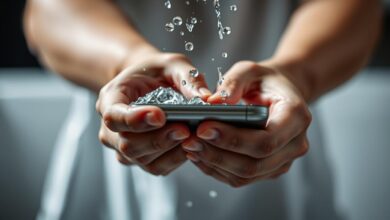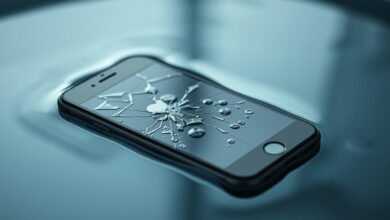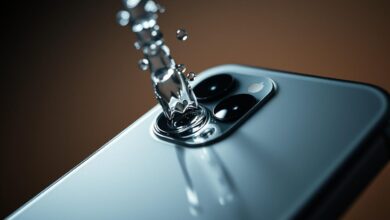how to clean speaker on iphone
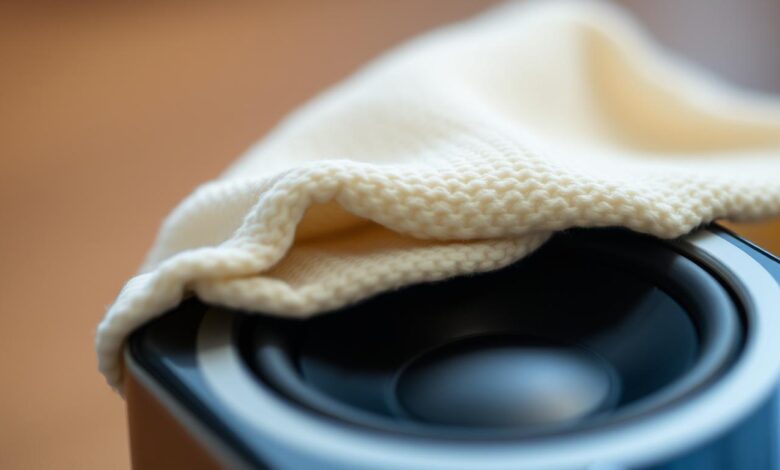
Keeping your iPhone’s speaker clean is key for great sound. Dust, dirt, and grime can build up over time. This can mess with how well you hear things. We’ll show you how to clean your iPhone speaker effectively.
Dirty speakers can make your sound muffled or distorted. But cleaning them is easy and can be done at home. For a detailed guide, check out wikiHow’s iPhone speaker cleaning guide. It has clear, step-by-step instructions.
Key Takeaways
- Use a soft-bristled toothbrush to gently remove dust and debris.
- Avoid using compressed air, as it can cause internal damage.
- Painter’s tape can be used to pick up grime and bits from the speaker.
- A toothpick can help break up large chunks of debris.
- An air blower can be used to gently dust away small particles.
Understanding Your iPhone’s Speaker System
Knowing how your iPhone’s speaker system works is key to keeping it clean and working well. The system is made to give you great sound, but it’s complex. This makes it hard to keep it in good shape.
Different Types of Speakers on iPhones
iPhones have many speakers for different uses. The main speakers are for playing media, and the earpiece speaker is for phone calls.
Main Speaker vs. Earpiece Speaker
The main speaker plays sound when you watch videos or listen to music. The earpiece speaker is for phone calls, sending sound to your ear. Knowing the difference helps you clean the right parts.
Speaker Grill Design Evolution
iPhone designs have changed over time, especially in speaker grills. Some designs trap dust and dirt. It’s important to know these changes to clean effectively.
How Speakers Get Dirty Over Time
Speakers on iPhones can get dirty with dust, lint, and other small stuff. This dirt can hurt how well they work.
Common Contaminants
- Dust
- Lint
- Other small particles
These can get stuck in the speaker grills. This makes the sound quality go down.
Impact on Sound Quality
Dirt in the speakers can make the sound muffled or distorted. Cleaning them regularly is important. It keeps the sound quality high and prevents damage.
Signs Your iPhone Speaker Needs Cleaning
A dirty iPhone speaker can really mess with your sound. Dirt, dust, and other stuff can build up in the speaker grills. This makes your sound quality go down.
If you notice any of these problems, it’s time to clean your iPhone speaker.
Muffled or Distorted Sound
If your iPhone’s speaker sounds muffled or distorted, it’s a sign of a problem. Dirt or debris is probably blocking the sound. You’ll notice this when you play music or watch videos.
Decreased Volume Output
If your volume isn’t as loud as it used to be, your speaker might be dirty. Even if you turn it up to max, you might still struggle to hear. This is because dirt is blocking the sound.
Crackling or Static Noises
Crackling or static noises from your iPhone speaker are annoying. They usually happen because of dirt or dust. Cleaning your speaker can fix this and make your sound better.
| Signs | Description |
|---|---|
| Muffled or Distorted Sound | Dirt or debris obstructing the speaker |
| Decreased Volume Output | Blockages in the speaker reducing volume |
| Crackling or Static Noises | Dirt or dust causing unwanted noises |
Recognizing these signs means you can clean your iPhone speaker and get your sound back. Cleaning regularly can stop these problems. It keeps your device working well.
Tools and Materials You’ll Need
Cleaning your iPhone speaker safely requires the right tools. The right materials ensure a deep clean without harming your device.
Safe Cleaning Tools for iPhones
Choosing the right tools for cleaning your iPhone speaker is key. Soft brushes and microfiber cloths are top picks for this job.
Soft Brushes and Microfiber Cloths
A soft-bristled brush can remove debris from the speaker grills. A microfiber cloth is great for wiping down the outside. These tools are safe for your iPhone and effective at removing dirt.
Specialized Electronics Cleaning Tools
There are tools made just for cleaning electronics, like anti-static brushes and precision cleaning swabs. They’re great for a detailed clean.
What to Avoid Using
Knowing what not to use is just as important. Some materials can actually harm your iPhone speaker.
Harmful Liquids and Chemicals
Stay away from liquids and chemicals. They can damage the speaker’s parts.
“Liquids and electronics do not mix well, so it’s best to keep them apart.”
Abrasive Materials
Abrasive materials like rough cloths can scratch the speaker grills. Stick with soft, gentle tools to keep your iPhone’s speaker in top shape.
Using the right tools and avoiding harmful materials helps keep your iPhone speaker clean. This is part of good iPhone speaker care.
Preparing Your iPhone for Cleaning
To clean your iPhone safely and effectively, you need to prepare it first. This involves a few easy steps. These steps help protect your device and ensure the speaker is cleaned well.
Powering Off Your Device
The first thing to do is turn off your iPhone. This step is key to avoid any accidental turns on or electrical shocks while cleaning. To turn off, press and hold the sleep/wake button until you see the “Slide to Power Off” slider. Then, drag it to the right.
Removing the Case and Screen Protector
Next, take off your iPhone case and screen protector. This lets you get to all parts of the device, like the speaker grills, where dust can build up. Carefully remove the case and screen protector to avoid damage.
Examining the Speaker Grills
Now, take a close look at the speaker grills. This step is important to see what you’re up against. Look for any dust or debris.
Identifying Debris Types
See if the debris is dry dust, wet dirt, or earwax. Knowing what kind of debris you have helps you choose the best cleaning method.
Assessing Contamination Level
Next, figure out how dirty the speaker grills are. This will tell you how deep the clean needs to be. Use a simple scale: light, moderate, or heavy contamination.
| Contamination Level | Description | Recommended Action |
|---|---|---|
| Light | A small amount of dust or debris | Gentle cleaning with a soft brush |
| Moderate | Visible debris, possibly some buildup | Use compressed air or a slightly damp cloth |
| Heavy | Significant buildup or stubborn debris | Precision cleaning tools or professional help |
How to Clean Speaker on iPhone Using Dry Methods
To keep your iPhone’s speaker working well, it’s key to know how to clean it dry. Dry cleaning is safe and works great for getting rid of dust that can mess with sound. Here, I’ll show you three dry ways to clean your iPhone’s speaker.
Soft Brush Technique
The soft brush method is a gentle and effective way to clean your iPhone’s speaker. It uses a soft-bristled brush to remove dust and debris from the speaker grills.
Choosing the Right Brush
Choose a brush with soft bristles that won’t scratch your iPhone’s speaker grills. A small, dry paintbrush or a makeup brush is perfect.
Proper Brushing Technique
Gently sweep the brush across the speaker grills to remove any visible debris. Be careful not to push too hard, as this could damage the speakers.
Compressed Air Method
Using compressed air is another effective dry method for cleaning your iPhone’s speaker. This technique can dislodge dust and dirt that’s accumulated in the speaker grills.
Safe Distance and Pressure
When using compressed air, hold the can at least 6 inches away from the speaker grills to avoid pushing debris further in. Use short bursts of air to clean the area.
Directional Considerations
Spray the compressed air into the speaker grills at different angles to ensure you loosen debris from all areas.
Masking Tape Trick
The masking tape trick is a simple, low-cost method for cleaning your iPhone’s speaker grills. This technique involves using masking tape to pick up dust and debris.
Creating a Tape Tool
To create a tape tool, wrap a small piece of masking tape around your finger with the sticky side out. This will allow you to gently pick up debris from the speaker grills.
Application Process
Gently press the tape tool onto the speaker grills and lift off. Repeat this process until you’ve removed as much debris as possible.
| Method | Effectiveness | Ease of Use |
|---|---|---|
| Soft Brush Technique | High | Easy |
| Compressed Air Method | High | Moderate |
| Masking Tape Trick | Moderate | Easy |
Using Sound Vibrations to Clean iPhone Speakers
Sound vibrations are a new way to clean iPhone speakers. This method uses sound waves to push out dirt from the speaker grills. It’s a gentle way to clean without using harsh chemicals.
Speaker Cleaning Apps
Many apps help clean iPhone speakers with sound vibrations. These apps make special sounds to get rid of dirt and dust.
Top Apps for Speaker Cleaning
Sound Test and Speaker Cleaner are top picks. You can find them in the App Store. People like them because they work well.
How to Use Them Effectively
First, download and install the app you choose. Then, follow the instructions to play the cleaning sound. Play it at a medium volume to protect your speakers.
Playing Specific Frequencies
Playing certain sounds can clean your iPhone speakers. Some sounds work better than others at getting rid of dirt.
Optimal Frequencies for Debris Removal
Frequencies between 100 Hz to 200 Hz are best for cleaning.
“Using the right frequency can make a significant difference in the cleaning process,” notes an expert in audio technology.
Duration and Volume Settings
Play the cleaning sound at a medium volume for 30 seconds to 1 minute. Adjusting the volume and time helps remove dirt without harming your speakers.
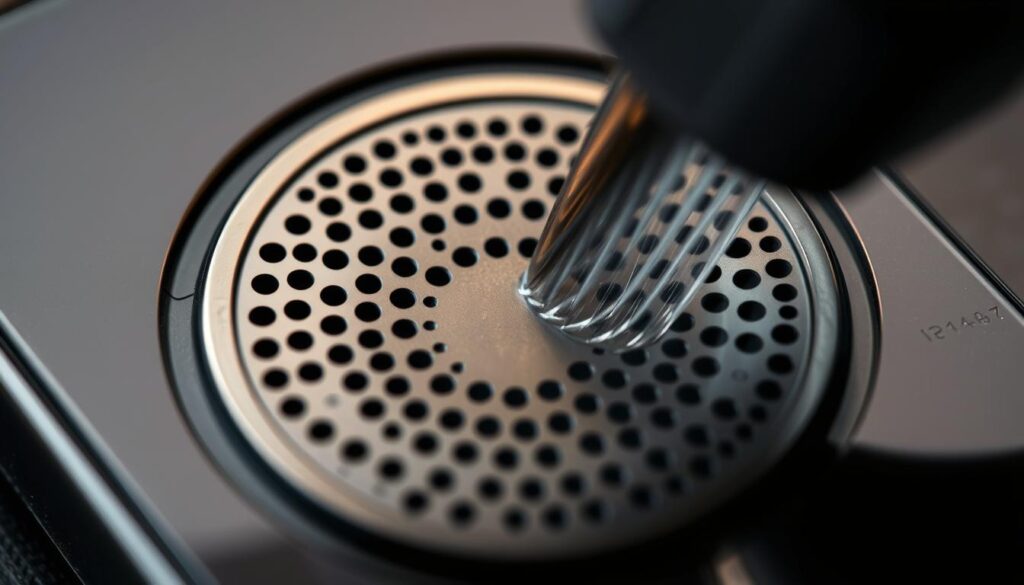
Cleaning iPhone Speaker Grills with Precision Tools
To clean your iPhone speaker grills well, use precision tools carefully. This way, you can clean them deeply without harming the parts. These tools are made to get into tight spots and take out dirt and dust.
Using Toothpicks Safely
Toothpicks can help clean your iPhone speaker grills, but be careful. It’s important to be gentle to avoid pushing dirt in more or damaging the speaker.
Wooden vs. Plastic Toothpicks
Both wooden and plastic toothpicks work, but pick a sturdy one. Plastic toothpicks are safer because they don’t splinter.
Gentle Scraping Technique
When using a toothpick, gently scrape the edges of the speaker grill. Don’t press too hard to avoid damaging the speaker.
Interdental Brushes Method
Interdental brushes are also great for cleaning your iPhone speaker grills. They come in different sizes, so you can find one that fits.
Selecting the Right Size
Pick an interdental brush that fits well in the speaker grill. This ensures it can clean without causing harm.
Circular Motion Technique
Put the interdental brush in the speaker grill and move it in circles. This helps loosen and remove dirt.
Precision Electronics Cleaning Tools
There are special tools made just for cleaning electronics, like iPhone speaker grills. These tools are gentle and won’t harm your device.
Anti-Static Brushes
Anti-static brushes prevent static damage to your iPhone. They are safe and effective for cleaning speaker grills.
Specialized Cleaning Pens
Special cleaning pens have soft brushes for small areas like speaker grills. They are easy to use and precise.
| Tool | Description | Effectiveness |
|---|---|---|
| Toothpicks | Can be used to gently scrape away debris | Moderate |
| Interdental Brushes | Effective for removing debris with a gentle circular motion | High |
| Anti-Static Brushes | Prevents static damage while cleaning | High |
Liquid-Based Cleaning Methods
Cleaning your iPhone speaker sometimes needs liquid methods. These can be good, but you must know the risks and how to do it right to avoid harm.
Isopropyl Alcohol Application
Using isopropyl alcohol is a common liquid method. It’s important to be precise to avoid getting it inside your iPhone.
Concentration Recommendations
To properly clean your iPhone speaker, use isopropyl alcohol that’s 70% or more. This helps clean well without leaving any residue.
Application with Cotton Swabs
Soak a cotton swab with isopropyl alcohol, but don’t make it too wet. Gently rub it on the speaker grills to get rid of dirt. Be careful not to press too hard, which could hurt the speaker.
Drying Process
After using isopropyl alcohol, let the speaker dry in the air before turning on your iPhone. This is key to avoid short circuits.
Risks and Precautions with Liquids
Liquid cleaning methods are good for iphone speaker care, but they have risks. Knowing these risks helps avoid damaging your iPhone.
Avoiding Liquid Damage
Liquids can get into your iPhone’s inside parts and cause damage. Always use liquids carefully and avoid getting them into the device’s openings.
Warranty Considerations
Using liquid cleaning might void your iPhone’s warranty if not done right. Check your warranty before trying any liquid cleaning method.
Knowing how to clean your iPhone speaker right and being aware of risks helps keep your speaker system in good shape.
Cleaning Different iPhone Models
As iPhone models change, so do their speakers. It’s important to know how to clean each one right. This way, you can keep your iPhone’s speaker working well without harming it.
iPhone 15/14/13 Series Speaker Cleaning
The iPhone 15, 14, and 13 have speakers that are tough and less likely to get clogged. But, they still need to be cleaned carefully.
Bottom Speaker Grill Access
Getting to the bottom speaker grill on these iPhones is easy. Use a soft brush or a dry cotton swab to remove dirt. Be gentle to avoid damaging the speaker.
Earpiece Speaker Considerations
The earpiece speaker is very sensitive. So, clean it gently. Don’t use liquids or sharp things. Instead, use a soft brush or compressed air.
iPhone 12/11/X Series Speaker Cleaning
The iPhone 12, 11, and X have slightly different speakers. Check the Apple website for cleaning tips for your model.
Speaker Grill Design Differences
These iPhones have different speaker grills. This means you might need a special cleaning tool. For example, some have a finer mesh that needs a finer brush.
Model-Specific Techniques
Look up the cleaning tips for your iPhone model. Some have special features that need extra care.
Older iPhone Models (SE/8/7/6)
Older iPhones, like the SE, 8, 7, and 6, have different speakers. They need careful cleaning because of their design.
Home Button Era Speakers
Models with a home button can get dirty around the button. Clean this area with a soft brush or dry cotton swab.
Addressing Older Grill Designs
Older grills can be easily damaged. So, clean them gently with dry methods. Avoid harsh chemicals or rough tools.

Addressing Stubborn Dirt and Debris
Cleaning your iPhone speaker of stubborn dirt and debris needs patience and the right methods. When simple cleaning doesn’t work, you must try harder.
Multiple-Step Cleaning Process
A multi-step cleaning process can really help. It combines different cleaning methods for the best results.
Combining Dry and Liquid Methods
Using both dry and liquid cleaning methods is smart. Begin with a dry method like compressed air or a soft brush to loosen dirt. Then, use a small amount of isopropyl alcohol on a cotton swab for the speaker grills. Make sure no liquid gets into the speaker openings.
Repeated Cleaning Cycles
One cleaning try might not be enough. Try the cleaning cycle again, switching between dry and liquid methods. Check the speaker after each try to avoid over-cleaning.
When to Seek Professional Help
If your iPhone speaker still has issues after trying many cleaning methods, it’s time for a pro. There are many ways to get your speaker fixed or cleaned by experts.
Apple Store Genius Bar Options
Going to the Apple Store Genius Bar is a good choice. The techs there can fix your speaker or clean it. It’s smart to book an appointment first.
Third-Party Repair Services
If there’s no Apple Store near you, third-party services are an option. Look for trusted and authorized repair shops. Read reviews and check ratings before picking a service.
Cleaning iPhone Speakers After Water Exposure
Water and iPhone speakers don’t mix well. You need to clean your iPhone right away after it gets wet. Water can damage the speakers, making sounds muffled or even stopping them from working.
Emergency Steps After Water Contact
Quick action is key when your iPhone gets wet. The sooner you act, the less damage your speakers might suffer.
Immediate Actions to Take
First, turn off your iPhone to avoid short circuits. Then, dry the outside gently with a soft cloth, focusing on the speaker grills. Don’t press or blow into the speakers, as this can push water in further.
What Not to Do
Don’t charge your iPhone or turn it on until it’s dry. Also, avoid using a hair dryer to dry it, as this can harm the inside parts.
Drying Techniques for Water-Damaged Speakers
After taking quick steps, dry out your iPhone’s speakers. You can use natural methods or desiccants.
Natural Drying Methods
Let your iPhone air dry in a cool, dry place for a few days. You can also use a soft cloth to wipe away moisture from the speaker grills.
Using Desiccants Safely
Desiccants, like silica gel packets, can absorb moisture. Put your iPhone in a container with the desiccant, but be careful not to let it get inside the iPhone.
Here’s a comparison of drying methods:
| Drying Method | Effectiveness | Risk Level |
|---|---|---|
| Air Drying | Moderate | Low |
| Desiccant | High | Moderate |
| Heat Source | Low | High |
The table shows desiccants are very effective but have some risks. Choose the best method for your situation.
Preventative Measures to Keep Speakers Clean
Keeping your iPhone speaker clean is easier than cleaning it later. A few simple steps can keep your iPhone sounding great and lasting longer.
Protective Cases and Covers
Protective cases and covers can block dust and debris from your iPhone’s speaker. Look for cases that fit well and are made of good materials.
Regular Maintenance Schedule
Cleaning your iPhone speaker regularly is key. A routine can help avoid problems.
Weekly Quick Cleaning
Wipe your iPhone with a soft cloth once a week. This removes dust and keeps it clean.
Monthly Deep Cleaning
For a deeper clean, use a soft-bristled brush or compressed air. This gets rid of dirt from the speaker grills. Be careful not to harm the speakers.
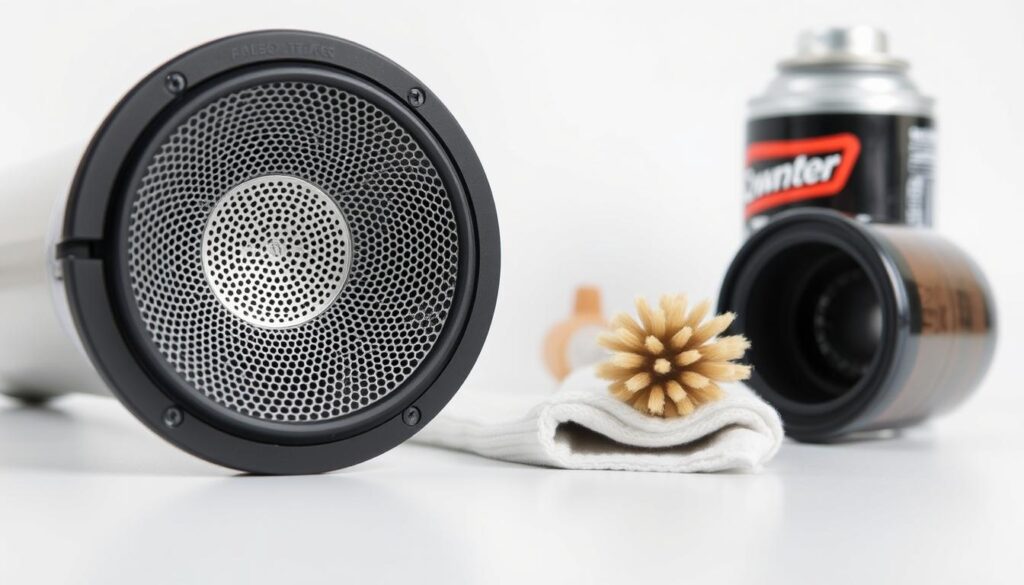
Common Mistakes to Avoid When Cleaning iPhone Speakers
Many iPhone users don’t know how to clean their speakers without damaging them. It’s important to know what to avoid to keep your speaker in good shape.
Damaging the Speaker Mesh
The speaker mesh is very delicate. It can get damaged easily when you clean. Be careful and gentle when you clean around this area.
Excessive Pressure Risks
Too much pressure can push dirt deeper into the mesh or hurt the inside parts. Use light touches when cleaning the speaker grill to avoid this.
Puncturing the Protective Mesh
Sharp objects or too much force can damage the mesh. Use the right tools and techniques to keep the mesh safe.
Using Excessive Force or Moisture
Too much force or moisture can harm your speaker. It’s important to find the right balance between cleaning and avoiding damage.
Liquid Damage Prevention
Liquids can get into the speaker and cause damage. Avoid using liquids if you can. If you must use liquid, use a small amount of isopropyl alcohol on a soft cloth.
Gentle Handling Techniques
When cleaning your iPhone speaker, be gentle. Use soft-bristled brushes or dry cloths to remove dirt. Don’t press too hard.
Knowing these common mistakes and taking the right steps can help you clean your iPhone speaker safely. The best way to clean iPhone speaker is to be gentle, use the right tools, and avoid too much force or moisture.
- Be gentle when cleaning the speaker grill
- Avoid using sharp objects or excessive force
- Use soft-bristled brushes or dry cloths
- Minimize the use of liquids
Troubleshooting After Cleaning
Even after cleaning, some iPhone users might still have speaker problems. If your iPhone speaker isn’t working right after cleaning, you need to find out why. This will help you fix the issue.
Speaker Still Not Working Properly
If your iPhone speaker still has issues, figure out if it’s a software or hardware problem. Knowing the cause will tell you what to do next.
Software vs. Hardware Issues
Software problems might be glitches or settings that need fixing. On the other hand, hardware issues could be physical damage or debris in the speaker. Understanding the problem is crucial to solving it.
Testing Speaker Functionality
To check if your iPhone speaker works, play music or a video with clear sound. If the sound is still bad or weak, it might be a hardware issue.
“The best way to test your speaker is with a variety of audio sources.”
When to Contact Apple Support
If you can’t fix the problem yourself, it’s time to call Apple Support. Knowing when to ask for help can save you time and ensure your iPhone is fixed right.
AppleCare Coverage Options
If your iPhone is still under AppleCare or warranty, you might get free repairs or a new one. Checking your coverage is important before you call support.
Preparing for Technical Support
Before you call Apple Support, have your iPhone details ready. This includes its model, iOS version, and a clear description of the problem.
Conclusion
Cleaning your iPhone’s speaker is easy and keeps it working well. By following the steps in this article, you can keep your iPhone’s sound quality high. This helps your speaker last longer.
Regular cleaning stops problems like muffled sound and static noises. Using dry cleaning, sound vibrations, and special tools keeps your speaker in great shape.
To keep your speaker clean, check and clean the grills often. Avoid harsh chemicals and don’t use too much force. Also, use protective cases and covers. These steps help you enjoy clear sound from your iPhone.
FAQ
How often should I clean my iPhone speaker?
Clean your iPhone speaker every 1-2 weeks to avoid dust buildup. If sound quality drops, clean it more often.
Can I use a vacuum cleaner to clean my iPhone speaker?
No, vacuum cleaners can harm your iPhone. Use a soft-bristled brush or compressed air made for electronics instead.
Is it safe to use isopropyl alcohol to clean my iPhone speaker?
Yes, but use 70% isopropyl alcohol or less. Apply it to a cotton swab and avoid sensitive areas. Wipe gently and let it dry.
How do I clean the earpiece speaker on my iPhone?
Use a soft-bristled brush or cotton swab to remove debris. Avoid liquids and don’t push too hard to avoid damage.
Can I use a toothpick to clean my iPhone speaker grill?
Yes, but be careful not to damage the mesh. Gently remove debris with a toothpick and then brush off dust.
What should I do if my iPhone speaker is still not working properly after cleaning?
Check for updates, restart your device, and test the speaker. If it still doesn’t work, contact Apple Support or visit an authorized service provider.
How can I prevent my iPhone speaker from getting dirty in the future?
Use a protective case and clean the speaker regularly. Dust plugs or covers can also help when not in use.
Are there any specific iPhone speaker cleaning apps you recommend?
Yes, apps like Sound Test, Speaker Cleaner, and Frequency Sound can help remove debris with sound vibrations.
Can I clean my iPhone speaker after water exposure?
Yes, but be careful. Dry the outside with a soft cloth and avoid charging or using liquids. Use desiccants or uncooked rice to dry the inside, but be cautious not to push debris further into the speaker.
